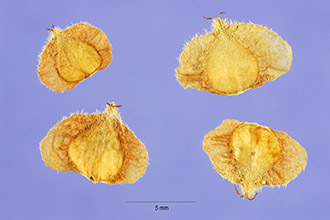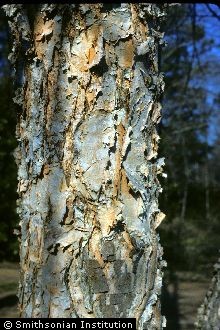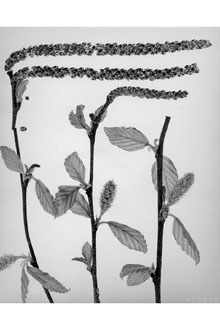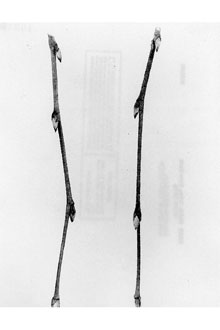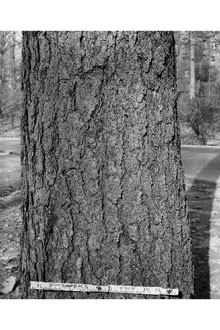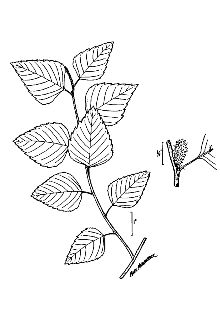River Birch
Scientific Name: Betula nigra L.
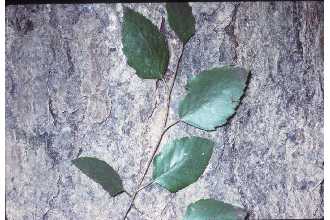
| General Information | |
|---|---|
| Usda Symbol | BENI |
| Group | Dicot |
| Life Cycle | Perennial |
| Growth Habits | Tree |
| Native Locations | BENI |
Plant Guide
Alternative Names
Japanese red birch, black birch, red birch, water birch
Uses
Economic: River birch sap can be fermented to make birch beer or vinegar. The wood is used to manufacture inexpensive furniture, woodenware, wooden shoes, basket materials, toys, staves, and fuel. Ethnobotanic: The leaves were chewed, or used as an infusion in the treatment of dysentery. An infusion of the bark was used to treat stomach problems and difficult urination (Moerman 1998). Landscaping &Wildlife: Betula nigra is a very attractive ornamental tree. It is a desirable specimen for estates, golf courses, parks, and public grounds. Many species of birds eat the seeds including wild turkey and grouse. The leaves are browsed by white-tailed deer. Conservation: River birch is used for strip mine reclamation and erosion control (Grelen 1990). It is used in forested riparian buffers to help reduce stream bank erosion, protect water quality, and enhance aquatic environments.
Status
Please consult the PLANTS Web site and your State Department of Natural Resources for this plant’s current status, such as, state noxious status and wetland indicator values, , Use soil moisture sensors to measure the soil moisture of River Birch.
Description
General: Birch family (Betulaceae). River birch is a deciduous medium to large-sized native tree. The leaves are alternate, double serrated, wedge-shaped, and sharp pointed. The flowers are unisexual, borne in separate male and female catkins on the same tree. The bark is light brown to buff, paperlike; exfoliating on young trees, turning to scaly bark on older trees. Robert Mohlenbrock Midwestern Wetland Flora USDA, NRCS, Wetland Sciences Institute @ PLANTS Distribution: River birch is distributed throughout North America. It extends from southern New England, west to Kansas and Minnesota, and south to Texas and Florida. For current distribution, please consult the Plant profile page for this species on the PLANTS Web site.
Adaptation
River birch can survive on drier soils, although it is best adapted to moist soils and is usually found along stream banks and in swampy bottomlands that are periodically flooded. Maximum development is reached in fertile areas with a pH of 6.5 to 4.0. It is intolerant of shade and requires full sunlight.
Establishment
Propagation by Seed: Sow seeds in containers or seed trays containing a seed germination medium to which a slow release fertilizer is added. Firm the medium and sow seeds thinly and evenly on top, and cover to desired depth with planting medium (Heuser 1997). Place pots in a sunny location in a cold frame. When seedlings are large enough to handle they should be placed into individual pots and grown in a cold frame for their first winter.
Management
Fertilize young trees in late winter before new growth begins to ensure faster growth. Don’t prune this birch and other birches until summer because they are “bleeders” and should not be cut when the sap is flowing. River birch is quite disease resistant but has severe problems in early spring with aphids and is favored by gypsy moth larvae. Cultivars, Improved and Selected Materials (and area of origin) Readily available through commercial nurseries. Contact your local Natural Resources
Conservation
Service (formerly Soil Conservation Service) office for more information. Look in the phone book under ”United States Government”. The Natural Resources Conservation Service will be listed under the subheading “Department of Agriculture.”
References
Britton, N.L. 1908. North American trees. Henry Holt & Company, New York, New York. Coombes, A.J. 1992. Eyewitness handbooks: trees. Dorling Kindersley, Inc., New York, New York. Dirr, M.A. 1997 Dirr’s hardy trees and shrubs: an illustrated encyclopedia. Timber Press, Inc., Portland, Oregon. Dirr, M.A. 1990. Manual of woody landscape plants: their identification, ornamental characteristics, culture, propagation, and uses. 4th ed. Stipes Publishing Co., Champaigne, Illinois. Great Plains Flora Association 1986. Flora of the great plains. University Press of Kansas, Lawerence, Kansas. Grelen, H.E. 1990. Betula nigra. Silvics of North America. Volume 2. Hardwoods. United States Department of Agriculture. Agriculture Handbook 654, Washington, D.C. Grimm, W.C. 1967. Familiar trees of America. Harper & Row, Publishers, New York, New York. Grimm, W.C. 1983. The illustrated book of trees. Stackpole Books, Mechanicsburg, Philadelphia, Pennsylvania. Heuser, C.W. 1997 The complete book of plant propagation. The Taunton Press, Newtown, Connecticut. Harrar, E.S. & J.G. Harrar 1962. Guide to southern trees. 2nd ed. Dover Publications Inc., New York, New York. Lyon, H.H. & W.T. Johnson 1988. Insects that feed on trees and shrubs. 2nd ed. Cornell University Press, Ithaca, New York. Moerman, D. 1998. Native American ethnobotany. Timber Press, Oregon. Odgenwald, N.G. & J.R. Turner. Plants for the south: a guide for landscape design. Claitor’s Publishing Division, Baton Rouge, Louisiana. Preston, R.J. Jr. 1948. North American trees. 2nd ed. The Iowa State College Press, Ames, Iowa. Sargent, C.S. 1933. Manual of the trees of North America. The Riverside Press, Cambridge, Massachusetts. Rosendahl, C.O. 1955. Trees & shrubs of the upper midwest. University of Minnesota Press, Minneapolis, Minnesota.
Fact Sheet
Alternate Names
black birch, red birch, water birch
Uses
Buffers: River birch fits well into buffer installations along with its companion species. Erosion Control: It has been used successfully in strip mine reclamation and in erosion control. Wildlife: Its young twigs, buds and foliage are browsed by white-tailed deer; seeds are eaten by grouse, turkeys, small birds and rodents. Its spring ripening make it particularly valuable. Timber: Its wood is locally used for fuel and occasionally for inexpensive furniture, basket hoops and turned articles; artificial limbs and toys. Recreation and Beautification: River birch is useful in native-oriented landscapes. It has a balanced and well-formed growth habit and interesting features through all seasons.
Status
Please consult the PLANTS Web site and your State Department of Natural Resources for this plant’s current status (e.g. threatened or endangered species, state noxious status, and wetland indicator values).
Description
River birch is native to the eastern United States; south to Florida, north to Minnesota and west to Kansas; it is restricted to stream banks and other moist places. The tree can grow as tall as 40 to 70 feet and 15 to 30 inches in diameter. The bark is exfoliating; gray-brown to ivory or copper colored. The leaves are alternate, simple, 1-3 inches long, and oval-shaped with serrated edges; they are green above and whitish underneath. Flowers are inconspicuous. The winged fruit is small, brown, and borne in clusters in the spring. River birch bears an average of 375,000 seeds per pound. Root crowns and roots survive fire and sprout vigorously. The growth rate of river birch is typically 1.5 to 3 feet per year. Robert H. Mohlenbrock USDA NRCS 1989. Midwestern Wetland Flora @USDA NRCS PLANTS
Adaptation and Distribution
Distribution
Distribution
This species is restricted to low and medium elevations, and is most common along streams. River birch is at home on somewhat poorly drained to well drained soils making it an easy choice for riparian buffers throughout the range of the species. River birch, like other pioneer species, is not particularly pH sensitive and seems to be tolerant of soils that are in the 4.5 to 7.5 range. It will occasionally develop iron chlorosis in soil with neutral and higher pH. River birch is shade intolerant. For a current distribution map, please consult the Plant Profile page for this species on the PLANTS Website.
Establishment
Seed ripens and sheds in the spring and should be directly sown, Use soil moisture sensors to measure the soil moisture of River Birch., A seeding density of 25 to 44 per square foot is desirable, lightly covered or without covering if seedbed is kept moist, Stratification of birch seed is usually counter-productive, Seedlings have moderate growth rate and are usually outplanted as 2 year old bareroot stock, Given effective grass and weed control, river birch is easy to establish, Fertilization of tree and shrub seedlings at planting is generally not recommended, Defer any necessary fertility applications to the second year to avoid root damage, but only drastically disturbed soils are likely to need fertility inputs,
Management
Attention to weed control is the most critical factor for rapid establishment and early growth of riparian buffers. Grass competition for moisture, nutrients and light is generally more critical than broadleaf weed pressure, however there are broadleaved weeds that are serious threats--these are the very large annuals and the spreading perennials. The use of selected herbicides or a weed control fabric are two ways to reduce weed competition. State land grant college weed control guidelines for herbicide use should be reviewed for application rates and species compatibility. Consider the grass control herbicides which allow application contact with tree and shrub species. Weed control fabric can be placed at planting time and provide protection for 3-5 years. The initial expense is greater, but the overall expense may be less where weed pressure is heavy and multiple sprayings of herbicide would otherwise be necessary.
Plant Traits
Growth Requirements
| Temperature, Minimum (°F) | -31 |
|---|---|
| Adapted to Coarse Textured Soils | Yes |
| Adapted to Fine Textured Soils | Yes |
| Adapted to Medium Textured Soils | Yes |
| Anaerobic Tolerance | Medium |
| CaCO3 Tolerance | None |
| Cold Stratification Required | No |
| Drought Tolerance | Low |
| Fertility Requirement | Medium |
| Fire Tolerance | Medium |
| Frost Free Days, Minimum | 150 |
| Hedge Tolerance | None |
| Moisture Use | High |
| pH, Maximum | 6.5 |
| pH, Minimum | 3.0 |
| Planting Density per Acre, Maxim | 700 |
| Planting Density per Acre, Minim | 300 |
| Precipitation, Maximum | 80 |
| Precipitation, Minimum | 30 |
| Root Depth, Minimum (inches) | 20 |
| Salinity Tolerance | None |
| Shade Tolerance | Intolerant |
Morphology/Physiology
| Bloat | None |
|---|---|
| Toxicity | None |
| Resprout Ability | Yes |
| Shape and Orientation | Erect |
| Active Growth Period | Spring and Summer |
| C:N Ratio | Medium |
| Coppice Potential | Yes |
| Fall Conspicuous | No |
| Fire Resistant | No |
| Flower Color | Brown |
| Flower Conspicuous | No |
| Foliage Color | Green |
| Foliage Porosity Summer | Moderate |
| Foliage Porosity Winter | Porous |
| Foliage Texture | Medium |
| Fruit/Seed Conspicuous | No |
| Nitrogen Fixation | None |
| Low Growing Grass | No |
| Lifespan | Short |
| Leaf Retention | No |
| Known Allelopath | No |
| Height, Mature (feet) | 70.0 |
| Height at 20 Years, Maximum (fee | 35 |
| Growth Rate | Rapid |
| Growth Form | Multiple Stem |
| Fruit/Seed Color | Brown |
Reproduction
| Vegetative Spread Rate | Slow |
|---|---|
| Small Grain | No |
| Seedling Vigor | High |
| Seed Spread Rate | Rapid |
| Seed per Pound | 374400 |
| Fruit/Seed Persistence | No |
| Propagated by Tubers | No |
| Propagated by Sprigs | No |
| Propagated by Sod | No |
| Propagated by Seed | Yes |
| Propagated by Corm | No |
| Propagated by Cuttings | Yes |
| Bloom Period | Mid Spring |
| Commercial Availability | Routinely Available |
| Fruit/Seed Abundance | High |
| Fruit/Seed Period Begin | Spring |
| Fruit/Seed Period End | Spring |
| Propagated by Bare Root | Yes |
| Propagated by Bulb | No |
| Propagated by Container | Yes |
Suitability/Use
| Veneer Product | Yes |
|---|---|
| Pulpwood Product | Yes |
| Protein Potential | Low |
| Post Product | No |
| Palatable Human | No |
| Palatable Graze Animal | Low |
| Palatable Browse Animal | Medium |
| Nursery Stock Product | No |
| Naval Store Product | No |
| Lumber Product | No |
| Fuelwood Product | Low |
| Fodder Product | No |
| Christmas Tree Product | No |
| Berry/Nut/Seed Product | No |

